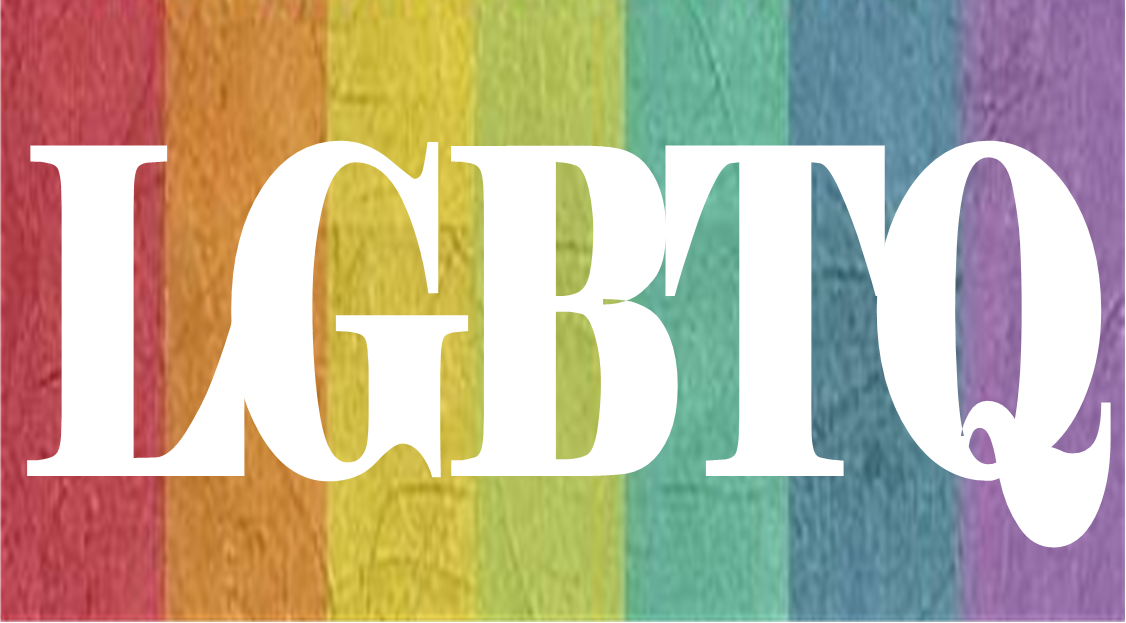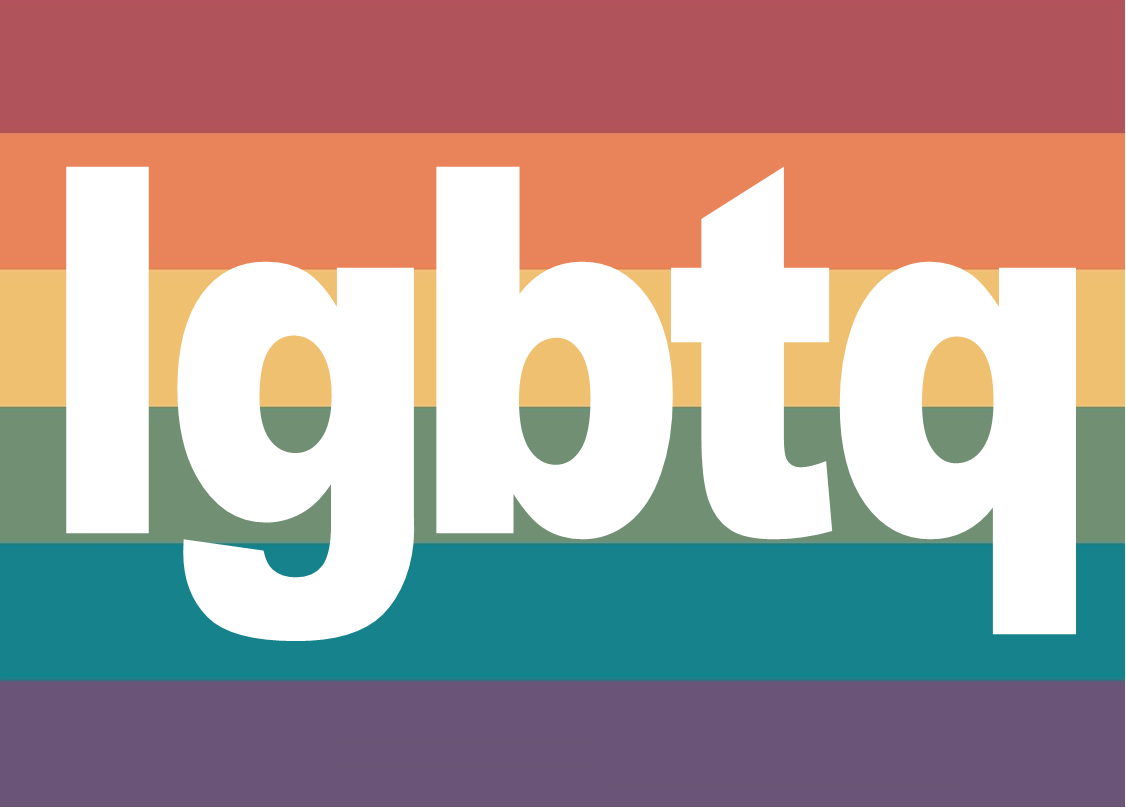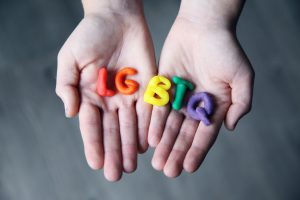|

HOME |
ABOUT | INDEX |
NEWS |
FACEBOOK |
CONTACT
LGBTQ
Acronym |
Initialism | Abbreviation | Umbrella Term
What Does LGBTQ
Mean?
"I've
asked lots of people what LGBTQ stands for.
So far
no one has given me a straight answer."
LGBTQ is
an acronym (or initialism) that stands for Lesbian, Gay, Bisexual,
Transgender, and Queer.
LGBTQ is an umbrella term that describes a group of
people defined by their sexual orientation, gender
identity, and gender expression. The LGBTQ acronym has
sometimes been expanded to also include: Q
(Questioning), A (Asexual), A (Ally), I (Intersex), P
(Pansexual), and so on. In a broad group of people who
might identify themselves as a members of a sexual
minority (outside the mainstream), other descriptors
certainly could be added to the list.



Wikipedia:
LGBTQ
Video: LGBTQ Facts to Celebrate
The Basics of LGBTQ
LGBTQ: Strength and Solidarity
Kinsey Institute: Who Are These LGBTQ Americans?
Video: Explaining the LGBTQ Acronym
DotGay Dictionary: What is the Alphabet?
Info: Profile of LGBTQ Community
Is it Time to Retire the LGBTQ Acronym
For a New Identity?
Seeking
Inclusivity
Why
Representation Matters
The LGBTQ abbreviation serves an important purpose. Not
only is it designed to be more inclusive, but it also
represents the self-identities of people who are
transgender and/or similar gender attracted.
The use of the acronym is intended to be an
all-encompassing way to recognize different gender
identities and sexual orientations. The addition of
other identities to the LGBT acronym also plays an
important role in recognizing and connecting them to a
larger community. It also means that these individuals
are able to gain greater recognition by society as a
whole. Rather than being erased, ignored, or denied,
acknowledgment can help foster greater visibility of
marginalized identities.

Visibility can also help create a greater sense of
self-affirmation of a person's identity. Research has
found that offering inclusive and affirmative
environments is important for LGBTQ youth. Research
also suggests that despite safety concerns, being
visible as a member of the LGBTQ community can be an
important way to feel a sense of pride in individual
identity. Affirming self-identity can help people feel
greater self-esteem, self-worth, and boost overall
mental well-being. This can be particularly important
since representation has long been lacking in mainstream
media.
The good news is that there have been improvements made
in recent years to change this. A recent GLAAD report
suggests that the representation of LGBTQ characters and
relationships on television is higher than ever
previously seen on TV. This includes greater diversity
and visibility of non-binary identities, although the
report notes that BIPOC characters are still
underrepresented.
Research and statistics suggest that LGBTQ youth have an
increased risk of a range of mental health and social
issues, often due to or exacerbated by isolation,
marginalization, and discrimination based on their
orientation or identity. Fostering inclusivity and
acceptance may be one way to help combat some of these
issues.
Wikipedia:
LGBTQ
LGBTQ Alphabet
LGBTQ: Strength and Solidarity
Acronyms and Words Words
Words
Info: Sexual Identity
Video: LGBTQ Facts to Celebrate
Out Right: Acronyms
Explained
Initials and Acronyms
The Basics of LGBTQ

Kinsey Institute: Who Are These LGBTQ Americans?
Info: Profile of LGBTQ Community
Video: The ABCs of LGBTQ
List:Famous LGBTQ People
Wikipedia: LGBTQ Community
Video: Explaining the LGBTQ Acronym
Is it Time to Retire the LGBTQ Acronym
For a New Identity?
DotGay Dictionary: What is the Alphabet?
Very Well: What Are Sexual Minorities?
LGBTQ
Acronyms
The act of politically grouping all non-heterosexual and
non-cisgender people into the acronym LGBTQ is an act of
exclusion. The LGBTQ acronym has expanded to LGBTQIA and
more, in an attempt to be as representative as possible.
But as the language used to describe these identities
continues to grow, so does the need for more appropriate
identification.

Currently,
the acronym could easily be expressed as a whopping 14
letters long: LGGBBTTQQIAAPP. This lengthy acronym
stands for lesbian, gay, genderqueer, bisexual, bigender,
transgender, trans, queer, questioning, intersex,
asexual, agender, pansexual and polyamorous. Some
versions include "2S" for two-spirit.
Not surprising,
to avoid an endless list of letters, you will sometimes see the acronym
expressed with a plus sign as in: LGBTQ+. It is
very appropriate, and a sign of inclusiveness, to
express the acronym as LGBTQ+.

One
advocacy group offers this initialism: LGBT2SGEQIAP+. They
define the letters as follows:
|
L
G
B
T
2S
GE
Q
Q
I
A
A
A
P
P
P
 |
Lesbian
Gay
Bisexual
Transgender
Two-Spirit
Gender Expansive
Queer
Questioning
Intersex
Agender
Asexual
Aromantic
Pansexual
Pangender, Polygender
Polyamorous

|

Initials and Acronyms
List:Famous LGBTQ People
LGBTQ Alphabet
Out Right: Acronyms
Explained
Wikipedia: LGBTQ Community
Very Well: What Are Sexual Minorities?
Info: Sexual and Gender Diversity
Acronyms and Words Words
Words
Putting the "+" at the end of the acronym signifies a
sincere and continuous effort to be inclusive of
other related identities and a commitment to an
understanding of identities that is ever-expanding,
always learning, always growing.
Some
suggest using shorter, more general abbreviations, like GSM,
which stands for gender and sexual minorities. GSM
serves as a much better acronymic blanket statement than
LGBTQ, because it does not specify any gender or sexual
identity whatsoever. In its ambiguity, GSM is not only
more accurate, but itís flexible. The name does not need
to be updated at the rapid pace of language
proliferation.
GSD (Gender and Sexual Diversities) has been suggested
as a more inclusive shorthand term. This designator would include
people who might be asexual, members of the BDSM/kink
community, and people who were in non-traditional
relationships that might be polyamorous or swingers.



At one
point, GSRM (Gender, Sexuality, and Romantic Minorities)
was also proposed.
Some also recommended MOGA (Marginalized Orientation and
Gender Alignments) and MOGII (Marginalized Orientations,
Gender Identity, and Intersex).
Looking
for a good all-around inclusive umbrella term, SOGI
(Sexual Orientation and Gender Identity) or SOGIESC
(Sexual Orientation, Gender Identity, Gender Expression,
Sex Characteristics) was also
suggested in some circles.
And if you
want to expand the umbrella and include the BDSM
community in the acronym, you can include a "K" for kink
or an "F" for fetish. You can add a "P" for polyamorous.
you could add a "B" for bears.
Info: Profile of LGBTQ Community
LGBTQ: Strength and Solidarity
Video: The ABCs of LGBTQ
The Basics of LGBTQ
Is it Time to Retire the LGBTQ Acronym
For a New Identity?
List: Famous LGBTQ People
Wikipedia: LGBTQ Community
Video: Explaining the LGBTQ Acronym
DotGay Dictionary: What is the Alphabet?
Very Well: What Are Sexual Minorities?

Initialism
Options
|
LGBTQ
LGBTQAI
GSM
GSD
GSRM
MOGA
MOGII
SOGI
SOGIE
SOGIESC
BIGLAT
 |
Lesbian,
Gay, Bisexual, Transgender, Queer
Lesbian, Gay, Bisexual, Transgender, Queer,
Asexual, Intersex
Gender and Sexual Minorities
Gender and Sexual Diversities
Gender, Sexuality, Romantic Minorities
Marginalized Orientation and
Gender Alignments
Marginalized Orientations,
Gender Identity, Intersex
Sexual Orientation and Gender Identity
Sexual Orientation and Gender
Identity/Expression
Sexual Orientation, Gender Identity, Gender
Expression, Sex Characteristics
Bisexual,
Intersex, Gay, Lesbian, Asexual, Transgender
 |
Sexual Minority
For purposes of sociological categorization, homosexual,
transgender, and queer people are considered to be
members of a sexual minority. The term sexual
minority refers to any identity, orientation,
lifestyle, or practice that doesnít comply with the
mainstream heterosexual or cisgender concept of normal
sexual or gender behavior.
The term
sexual minority can be used as an umbrella term
to encompass any group or individual who identifies as
gay, lesbian, bisexual, pansexual, polysexual, asexual,
transgender, transsexual, genderqueer,
gender-nonconforming, gender variant, agender, intersex,
polyamorous, kinky, or otherwise queer.

Wikipedia:
LGBTQ
LGBTQ Alphabet
Acronyms and Words Words
Words
Info: Sexual Identity
Video: LGBTQ Facts to Celebrate
Out Right: Acronyms
Explained
Initials and Acronyms
Kinsey Institute: Who Are These LGBTQ Americans?
As members
of a sexual minority, LGBTQ people are often subject to
the rules and attitudes of the majority heterosexual or
straight community. There is a potential in a
heterocentric environment (or ideology) to breed
heterosexism (or a heterosexist system) that results in
heterosexual privilege and homophobia. As with any
minority group, there is risk of oppression from members
of the majority group.
Using the
term sexual minority in certain conversations
helps to focus on the potential for oppression,
prejudice, and discrimination by the majority group. A
civilized society recognizes that minority voices must
be heard and that members of the minority community must
be included.
Some LGBTQ
people object to using the term sexual minority
and prefer the term LGBTQ. Reasons for these objections
may vary. For example, some LGBTQ people feel that the
term sexual minority reminds them about
discrimination and about being a minority. They want to
be not a distinct minority but an integral and
respectable part of the society. Some other LGBTQ people
dislike the term for being too inclusive, including
swingers, polyamorists, BDSM people and other perceived
"sexual strangers". These LGBTQ people want to make a
larger distance between these sexual practices and
sexual orientation/gender identity.

Some transgender and transsexual people dislike the term
sexual minority for yet another reason. They
argue that the phenomenon of transsexuality or
transgender has nothing to do with sex, sexual practices
or sexual orientation, but it relates to the gender,
gender dysphoria and gender-variant behavior or
feelings. Thus, they feel it is incorrect to classify
them as "sexual minority," when, in fact, they are
a gender-variant minority.
Wikipedia:
LGBTQ
Video: LGBTQ Facts to Celebrate
Kinsey Institute: Who Are These LGBTQ Americans?
Video: Explaining the LGBTQ Acronym
LGBTQ: Strength and Solidarity
DotGay Dictionary: What is the Alphabet?
Info: Profile of LGBTQ Community
Initials and Acronyms
Is it Time to Retire the LGBTQ Acronym
For a New Identity?
List:Famous LGBTQ People
LGBTQ Alphabet
Out Right: Acronyms
Explained
Wikipedia: LGBTQ Community
Very Well: What Are Sexual Minorities?
The Basics of LGBTQ
Info: Sexual and Gender Diversity
Acronyms and Words Words
Words

Impact and
Challenges
LGBTQ and related acronyms have become widely used in
recent years. It has also played a role in raising the
visibility of marginalized groups, including transgender
individuals.
Research suggests that while attitudes have shifted
towards greater acceptance, LGBTQ people still face
considerable homophobia and discrimination. Harassment,
bullying, and workplace discrimination are not
uncommon.
One advantage of utilizing a unified terminology is the
ability to engage in political advocacy. Social
solidarity can be used to improve visibility, combat
discrimination, and advance causes including
anti-discrimination and equality laws.
Unifying terms like LGBTQ can help people feel connected
to a larger group of people with shared experiences. But
the term can sometimes seem to imply that there is a
single, homogenous group when there are actually many
individual communities made up of diverse individuals.
These communities has some things in common, but each
identity has its own unique experiences and needs.
While the goal of this initialism is to raise visibility
and boost inclusivity, not everyone agrees about what
term or variation to use. The community has been
referred to by many words over the years, including many
that were intended to be hurtful. So itís not unusual
that the self-descriptors that people use can vary,
particularly when it comes to issues related to
self-expression, sexuality, and identity.

The LGBTQ
Umbrella
How broad is the LGBTQ umbrella? What sexual minorities
should be included under the Queer umbrella? Is the
LGBTQ/Queer community represented by more than just
sexual orientation and gender identity? Should the kink
community be included? Should asexuals be included?
Should the poly community be included? Should intersex
people be included?
I Don't Do Boxes: The Queer Umbrella
Orientation and Identity Under One Queer Umbrella
Is it Time to Retire the LGBTQ Acronym
For a New Identity?
Farrago Mag: The Queer Umbrella
Video: The Queer Umbrella
Should BDSM be Included Under the LGBTQ Umbrella?
Does Asexuality Fall Under the Queer Umbrella?
Video: Explaining the LGBTQ Acronym
DotGay Dictionary: What is the Alphabet?
Polyamory is Not Necessarily Queer
HOME
QUEER CAFE
│ LGBTQ Information Network │ Established 2017
|